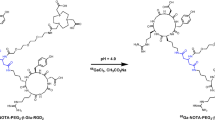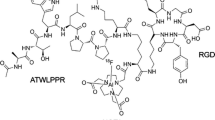Abstract
Purpose
Various radiolabeled Arg-Gly-Asp (RGD) peptides have been previously investigated for tumor integrin αvβ3 imaging. To further develop RGD radiotracers with enhanced tumor-targeting efficacy and improved in vivo pharmacokinetics, we designed a new RGD homodimeric peptide with two PEG4 spacers (PEG4 = 15-amino-4,7,10,13-tetraoxapentadecanoic acid) between the two monomeric RGD motifs and one PEG4 linker on the glutamate α-amino group (18F-labeled PEG4-E[PEG4-c(RGDfK)]2, P-PRGD2), as a promising agent for noninvasive imaging of integrin expression in mouse models.
Methods
P-PRGD2 was labeled with 18F via 4-nitrophenyl 2-18F-fluoropropionate (18F-FP) prosthetic group. In vitro and in vivo characteristics of the new dimeric RGD peptide tracer 18F-FP-P-PRGD2 were investigated and compared with those of 18F-FP-P-RGD2 (18F-labeled RGD dimer without two PEG4 spacers between the two RGD motifs). The ability of 18F-FP-P-PRGD2 to image tumor vascular integrin expression was evaluated in a 4T1 murine breast tumor model.
Results
With the insertion of two PEG4 spacers between the two RGD motifs, 18F-FP-P-PRGD2 showed enhanced integrin αvβ3-binding affinity, increased tumor uptake and tumor-to-nontumor background ratios compared with 18F-FP-P-RGD2 in U87MG tumors. MicroPET imaging with 18F-FP-P-PRGD2 revealed high tumor contrast and low background in tumor-bearing nude mice. Biodistribution studies confirmed the in vivo integrin αvβ3-binding specificity of 18F-FP-P-RGD2. 18F-FP-P-PRGD2 can specifically image integrin αvβ3 on the activated endothelial cells of tumor neovasculature.
Conclusion
18F-FP-P-PRGD2 can provide important information on integrin expression on the tumor vasculature. The high integrin binding affinity and specificity, excellent pharmacokinetic properties and metabolic stability make the new RGD dimeric tracer 18F-FP-P-PRGD2 a promising agent for PET imaging of tumor angiogenesis and for monitoring the efficacy of antiangiogenic treatment.






Similar content being viewed by others
References
Carmeliet P, Jain RK. Angiogenesis in cancer and other diseases. Nature 2000;407:249–57. doi: 10.1038/35025220.
Folkman J. Angiogenesis in cancer, vascular, rheumatoid and other disease. Nat Med 1995;1:27–31. doi: 10.1038/nm0195-27.
Folkman J. Role of angiogenesis in tumor growth and metastasis. Semin Oncol 2002;29:15–8.
Cai W, Chen X. Anti-angiogenic cancer therapy based on integrin αvβ3 antagonism. Anticancer Agents Med Chem 2006;6:407–28. doi: 10.2174/187152006778226530.
Knuuti J, Bengel FM. Positron emission tomography and molecular imaging. Heart 2008;94:360–7. doi: 10.1136/hrt.2007.118992.
Hawkins RA, Hoh C, Glaspy J, Choi Y, Dahlbom M, Rege S, et al. The role of positron emission tomography in oncology and other whole-body applications. Semin Nucl Med 1992;22:268–84. doi: 10.1016/S0001-2998(05)80121-7.
Sharma N, Neumann D, Macklis R. The impact of functional imaging on radiation medicine. Radiat Oncol 2008;3:25. doi: 10.1186/1748-717X-3-25.
Schindler TH, Zhang XL, Vincenti G, Mhiri L, Lerch R, Schelbert HR. Role of PET in the evaluation and understanding of coronary physiology. J Nucl Cardiol 2007;14:589–603. doi: 10.1016/j.nuclcard.2007.05.006.
Eliceiri BP, Cheresh DA. The role of alphav integrins during angiogenesis: insights into potential mechanisms of action and clinical development. J Clin Invest 1999;103:1227–30. doi: 10.1172/JCI6869.
Friedlander M, Theesfeld CL, Sugita M, Fruttiger M, Thomas MA, Chang S, et al. Involvement of integrins αvβ3 and αvβ5 in ocular neovascular diseases. Proc Natl Acad Sci USA 1996;93:9764–9. doi:10.1073/pnas.93.18.9764.
Brooks PC, Clark RA, Cheresh DA. Requirement of vascular integrin αvβ3 for angiogenesis. Science 1994;264:569–71. doi: 10.1126/science.7512751.
Gladson CL. Expression of integrin αvβ3 in small blood vessels of glioblastoma tumors. J Neuropathol Exp Neurol 1996;55:1143–9. doi: 10.1097/00005072-199611000-00005.
Li ZB, Cai W, Cao Q, Chen K, Wu Z, He L, et al. 64Cu-labeled tetrameric and octameric RGD peptides for small-animal PET of tumor αvβ3 integrin expression. J Nucl Med 2007;48:1162–71. doi: 10.2967/jnumed.107.039859.
Zhang X, Xiong Z, Wu Y, Cai W, Tseng JR, Gambhir SS, et al. Quantitative PET imaging of tumor integrin αvβ3 expression with 18F-FRGD2. J Nucl Med 2006;47:113–21.
Haubner R, Weber WA, Beer AJ, Vabuliene E, Reim D, Sarbia M, et al. Noninvasive visualization of the activated αvβ3 integrin in cancer patients by positron emission tomography and [18F]galacto-RGD. PLoS Med 2005;2:e70. doi: 10.1371/journal.pmed.0020070.
Kenny LM, Coombes RC, Oulie I, Contractor KB, Miller M, Spinks TJ, et al. Phase I trial of the positron-emitting Arg-Gly-Asp (RGD) peptide radioligand 18F-AH111585 in breast cancer patients. J Nucl Med 2008;49:879–86. doi: 10.2967/jnumed.107.049452.
Wu Y, Zhang X, Xiong Z, Cheng Z, Fisher DR, Liu S, et al. microPET imaging of glioma integrin αvβ3 expression using 64Cu-labeled tetrameric RGD peptide. J Nucl Med 2005;46:1707–18.
Li ZB, Chen K, Chen X. 68Ga-labeled multimeric RGD peptides for microPET imaging of integrin αvβ3 expression. Eur J Nucl Med Mol Imaging 2008;35:1100–8. doi: 10.1007/s00259-007-0692-y.
Wu Y, Cai W, Chen X. Near-infrared fluorescence imaging of tumor integrin αvβ3 expression with Cy7-labeled RGD multimers. Mol Imaging Biol 2006;8:226–36. doi: 10.1007/s11307-006-0041-8.
Shi J, Wang L, Kim YS, Zhai S, Liu Z, Chen X, et al. Improving tumor uptake and excretion kinetics of 99mTc-labeled cyclic arginine-glycine-aspartic (RGD) dimers with triglycine linkers. J Med Chem 2008;51:7980–90. doi: 10.1021/jm801134k.
Liu Z, Niu G, Shi J, Liu S, Wang F, Liu S, et al. (68)Ga-labeled cyclic RGD dimers with Gly(3) and PEG (4) linkers: promising agents for tumor integrin alpha (v)beta(3) PET imaging. Eur J Nucl Med Mol Imaging 2009. doi: 10.1007/s00259-008-1045-1
Wang L, Shi J, Kim YS, Zhai S, Jia B, Zhao H, et al. Improving tumor-targeting capability and pharmacokinetics of 99mTc-labeled cyclic RGD dimers with PEG4 linkers. Mol Pharm 2009;6:231–45. doi: 10.1021/mp800150r.
Chen X, Park R, Hou Y, Khankaldyyan V, Gonzales-Gomez I, Tohme M, et al. MicroPET imaging of brain tumor angiogenesis with 18F-labeled PEGylated RGD peptide. Eur J Nucl Med Mol Imaging 2004;31:1081–9. doi: 10.1007/s00259-003-1452-2.
Wu Z, Li ZB, Cai W, He L, Chin FT, Li F, et al. 18F-labeled mini-PEG spacered RGD dimer (18F-FPRGD2): synthesis and microPET imaging of αvβ3 integrin expression. Eur J Nucl Med Mol Imaging 2007;34:1823–31. doi: 10.1007/s00259-007-0427-0.
Haubner R, Kuhnast B, Mang C, Weber WA, Kessler H, Wester HJ, et al. [18F]Galacto-RGD: synthesis, radiolabeling, metabolic stability, and radiation dose estimates. Bioconjug Chem 2004;15:61–9. doi: 10.1021/bc034170n.
Lacroix M. MDA-MB-435 cells are from melanoma, not from breast cancer. Cancer Chemother Pharmacol 2009;63:567. doi: 10.1007/s00280-008-0776-9.
Rae JM, Creighton CJ, Meck JM, Haddad BR, Johnson MD. MDA-MB-435 cells are derived from M14 melanoma cells – a loss for breast cancer, but a boon for melanoma research. Breast Cancer Res Treat 2007;104:13–9. doi: 10.1007/s10549-006-9392-8.
Chen X, Hou Y, Tohme M, Park R, Khankaldyyan V, Gonzales-Gomez I, et al. Pegylated Arg-Gly-Asp peptide: 64Cu labeling and PET imaging of brain tumor αvβ3-integrin expression. J Nucl Med 2004;45:1776–83.
Cai W, Chen K, Mohamedali KA, Cao Q, Gambhir SS, Rosenblum MG, et al. PET of vascular endothelial growth factor receptor expression. J Nucl Med 2006;47:2048–56.
Cai W, Wu Y, Chen K, Cao Q, Tice DA, Chen X. In vitro and in vivo characterization of 64Cu-labeled Abegrin, a humanized monoclonal antibody against integrin αvβ3. Cancer Res 2006;66:9673–81. doi: 10.1158/0008-5472.CAN-06-1480.
Dijkgraaf I, Kruijtzer JA, Liu S, Soede AC, Oyen WJ, Corstens FH, et al. Improved targeting of the αvβ3 integrin by multimerisation of RGD peptides. Eur J Nucl Med Mol Imaging 2007;34:267–73. doi: 10.1007/s00259-006-0180-9.
Janssen ML, Oyen WJ, Dijkgraaf I, Massuger LF, Frielink C, Edwards DS, et al. Tumor targeting with radiolabeled αvβ3 integrin binding peptides in a nude mouse model. Cancer Res 2002;62:6146–51.
Ferrara N. Vascular endothelial growth factor: basic science and clinical progress. Endocr Rev 2004;25:581–611. doi: 10.1210/er.2003-0027.
Liu S. Radiolabeled multimeric cyclic RGD peptides as integrin αvβ3 targeted radiotracers for tumor imaging. Mol Pharm 2006;3:472–87. doi: 10.1021/mp060049x.
Dijkgraaf I, Boerman OC, Oyen WJ, Corstens FH, Gotthardt M. Development and application of peptide-based radiopharmaceuticals. Anticancer Agents Med Chem 2007;7:543–51.
Boturyn D, Coll JL, Garanger E, Favrot MC, Dumy P. Template assembled cyclopeptides as multimeric system for integrin targeting and endocytosis. J Am Chem Soc 2004;126:5730–9. doi: 10.1021/ja049926n.
Mammen M, Choi S, Whitesides GM. Polyvalent Interactions in biological systems: implications for design and use of multivalent ligands and inhibitors. Angew Chem Int Ed Engl 1998;37:2754–94.
Janssen M, Oyen WJ, Massuger LF, Frielink C, Dijkgraaf I, Edwards DS, et al. Comparison of a monomeric and dimeric radiolabeled RGD-peptide for tumor targeting. Cancer Biother Radiopharm 2002;17:641–6. doi: 10.1089/108497802320970244.
Chen X, Tohme M, Park R, Hou Y, Bading JR, Conti PS. Micro-PET imaging of αvβ3-integrin expression with 18F-labeled dimeric RGD peptide. Mol Imaging 2004;3:96–104. doi: 10.1162/1535350041464892.
Wu Z, Li ZB, Chen K, Cai W, He L, Chin FT, et al. microPET of tumor integrin αvβ3 expression using 18F-labeled PEGylated tetrameric RGD peptide (18F-FPRGD4). J Nucl Med 2007;48:1536–44. doi: 10.2967/jnumed.107.040816.
Chen X, Park R, Tohme M, Shahinian AH, Bading JR, Conti PS. MicroPET and autoradiographic imaging of breast cancer αv-integrin expression using 18F- and 64Cu-labeled RGD peptide. Bioconjug Chem 2004;15:41–9. doi: 10.1021/bc0300403.
Haubner R. αvβ3-integrin imaging: a new approach to characterise angiogenesis? Eur J Nucl Med Mol Imaging 2006;33(Suppl 1):54–63. doi: 10.1007/s00259-006-0136-0.
Acknowledgments
This work was supported in part by the National Cancer Institute (R01 120188, R01 CA119053, R21 CA121842, R21 CA102123, P50 CA114747, U54 CA119367 and R24 CA93862 to X.C.; and R01 CA115883 to S.L.), and by the Department of Energy (DE-FG02–08ER64684 to S.L.). We thank Dr. Kai Chen for kind technical support and also thank the cyclotron teams at Stanford University for 18F-F− production. Z. Liu would like to acknowledge the China Scholarship Council (CSC) for partial financial support during his study at Stanford University.
Author information
Authors and Affiliations
Corresponding author
Electronic supplementary material
Below is the link to the electronic supplementary material.
Supplementary Figures
(DOC 5043 KB)
Rights and permissions
About this article
Cite this article
Liu, Z., Liu, S., Wang, F. et al. Noninvasive imaging of tumor integrin expression using 18F-labeled RGD dimer peptide with PEG4 linkers. Eur J Nucl Med Mol Imaging 36, 1296–1307 (2009). https://doi.org/10.1007/s00259-009-1112-2
Received:
Accepted:
Published:
Issue Date:
DOI: https://doi.org/10.1007/s00259-009-1112-2




